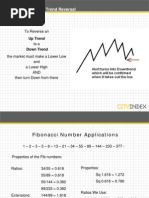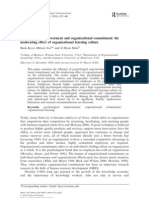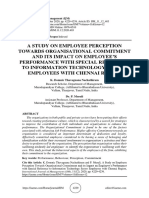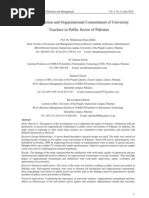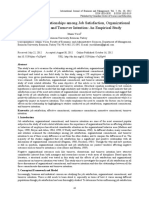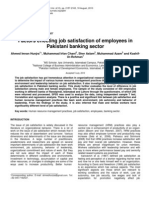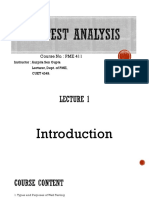Management Science Letters
Management Science Letters
Uploaded by
Rafael BarrosCopyright:
Available Formats
Management Science Letters
Management Science Letters
Uploaded by
Rafael BarrosOriginal Title
Copyright
Available Formats
Share this document
Did you find this document useful?
Is this content inappropriate?
Copyright:
Available Formats
Management Science Letters
Management Science Letters
Uploaded by
Rafael BarrosCopyright:
Available Formats
Management Science Letters 3 (2013) 181194
Contents lists available at GrowingScience
Management Science Letters
homepage: www.GrowingScience.com/msl
A study on the effect of organizational climate on organizational commitment: A case study of
educational system
Bahman Saeidipour*
Professor of Educational Sciences of Payame Noor University, I. R. of Iran
CHRONICLE
Article history:
Received June 28, 2012
Received in revised format
26 October 2012
Accepted 10 November 2012
Available online
November 12 2012
Keywords:
Organizational climate
Organizational commitment
Continuous commitment
Affective
Normative
Organization
ABSTRACT
Building strong commitment among organizational employees plays an important role in
reducing delays and displacement. It can also increase employee efficiency, employees' mental
freshness and manifesting both organizational admirable targets and personal goals. The
purpose of this study is to detect and to forecast the impact of organizational climate on level of
organizational commitment among staff education in city of Kermanshah located in west part
Iran. The survey designs questionnaires and collects necessary information using a descriptive
survey. The statistical population includes all 921 employees who were either enrolled in
administration level or work as teacher in all areas of city of Kermanshah. The study selects
300 individuals from the statistical population randomly. The proposed model of this paper uses
factor analysis to determine the most important factors influencing organizational commitment
and Cronbach alpha is used to validate the results. The results show that there is a significant
relationship between the components of role and paying enough attention to goals, the variable
organizational climate, and the whole variable dimensions of organizational commitment. The
other observation is that there was a weak relationship with some components of social
commitment, and there was not any significant relationship with other aspects. Results of
multivariate regression analysis shows that there was a high correlation between organizational
climate and social commitment (t-student=6.208).
2013 Growing Science Ltd. All rights reserved.
1. Introduction
Organizational climate and commitment are the most important issues in any organization.
Commitment can be promoted or improved through a specific selection of employees, monitoring
job, educational reasoning, and organizational socialization (O'Reilly et al., 1990). Organizations are
considered as major parts of today's society and human being needs for survival and living are
planned through. In fact, many people state our society as an organizational society where people are
born, educate, work and die (Baugh & Roberts, 1994; Saburi, 2004).
*Corresponding author.
E-mail addresses: bahman_saeidipour@yahoo.com (B. Saeidpour)
2013 Growing Science Ltd. All rights reserved.
doi: 10.5267/j.msl.2012.11.014
182
Security is one of the most important components of organizational commitment and lack of
organizational commitment could create job stress, inefficient and long working days. In the context
of increasingly unstable economic conditions, it is important for managers to setup good background
for improving organizational commitment (Giddens, 2010). On the other hand, low levels of
discipline, confidence and responsibility are created in organization under the circumstances of the
contemporary world, which influence employee commitment. In other words, it is important to build
a mutual trust between employer and employee to increase organizational commitment. Human
resources are the primary component of any organizations and it is important to make any changes
within the organizations to increase their commitment. Azad and Sadeghi (2012) indicated four
factors influencing organizational commitments. The first factor is associated with cultural factor, the
second issues are human resource based factors while the third factor is related to the behavior based
factors and finally empowering based factors are the last item. They used structural equation
modeling and the results showed that the third factor, behavior based components, was the most
important factor followed by the second factor, human resource factor. In addition, the third
important factor was cultural issues followed by empowering factors.
Bahramzadeh and Khosroabadi (2012) investigated the relationship between organizational
commitment and knowledge sharing in a case study of university employee cooperation. They
discussed that knowledge sharing is an important item on helping organizations reach their
objectives, it helps distribution of overall awareness among workers and creates better environment
for adding more value. There are literally various factors impacting knowledge sharing and
organizational commitment is one of the most important items. They presented a study in one of
privately held universities located in city of Bojnourd, Iran and selected a sample size 145 out of 236
people from both regular employees and university professors and used various tests such as Pearson
correlation test to investigate the results. The proposed model of the paper confirmed that there was a
positive and meaningful relationship between these two components when the level of significance
was set to five percent. The results of this survey also disclosed that while ethical commitment and
normative played important impact on knowledge sharing, continuity had no significant effect on
knowledge sharing within organization. The other observation is that while gender and age had no
effect on knowledge sharing, higher educational background was an important factor on knowledge
sharing.
Abid et al. (2012) explored the authentic leadership styles of an entrepreneur and its effects on
employees commitment and satisfaction. By using the authentic leadership model, this study looked
to give a tentative test of the connection among employees awareness of the business creator as an
authentic leader and the employees attitudes. Findings were that the opinion of employees about
authentic leadership serves as the intoxicating analyst of employee job satisfaction and organizational
commitment. Nazeri et al. (2012) analyzed the impact of the staffs wellbeing stated as independent
variable and the work locus of control as the moderator factor related to the organizational
commitment and the staffs wellbeing. To accomplish the objective, they implemented regression
analysis and concentrated on the ones capability to forecast the staffs wellbeing and it investigated
the impacts of the work locus of control as a moderator on the organizational commitment. They
explained that the staffs wellbeing maintained a negative relationship with the continuance
commitment and a positive relationship with the affective and normative commitments. Moreover,
the effect of the work locus of control, as moderator, on the relationship between the staffs wellbeing
and their organizational commitment relational and had some necessities.
Iravani (2012) explained that job satisfaction could have sustainable growth in any business units. In
fact, he explained that when an unsatisfied employee leaves, the business unit not only loses an
employee but also it loses an intangible asset. Therefore, it is essential to evaluate overall job
satisfaction occasionally and provide some guidelines for improving work conditions. They
investigated a case study and reported that there were some positive relationships between job
183
B. Saeidpour / Management Science Letters 3 (2013)
satisfaction and other factors including wage increase, psychological needs, physical equipments,
entertainment equipment and work-team. The purpose of this study is to compare organizational
commitment with organizational climate components. In line with this goal, the partial goals are as
follows,
1-Cognition organizational climate of staff education of Kermanshah
2-Cognition the organizational commitment of staff education of Kermanshah
3-Determine the effect of organizational climate on organizational commitment
Santos (1998) studied related factors with job commitment, organizational, and professional of
teachers of development organization in the Dominican Republic and reported that there were
positive and significant relationships between job prestige and job commitment, organizational
credibility and job commitment, professional reputation and job commitment. Tsai and Wang (2004)
investigated the role of pay satisfaction as an intervening variable, on relationship between
organizational commitment and professional and studied the important factors influencing on
professional and organizational commitment. They reported a positive and significant relationship
between professional commitment and organizational.
Jacobus (1994) investigated the relationship between organizational climate, management
development and job satisfaction of teachers where the goal was to determine important factors
increasing the performance of a teacher as a skilled worker. The results showed that a positive
organizational climate effectively through motivate teachers to do their educational functions, makes
it easy to management work and the ability of teachers to achieve its goals be encouraging and
increases (Jacobus, 1994).
A set of internal characteristics, which distinguish three offices of education and administration of
city of Kermanshah from each other and the impact of the behavior on their members is called
organization climate. To be more precise, climate is defined as relatively stable quality office
environment where employees have good experience with. Climate influences employees' behaviors
and it is based on the collective perceptions of behavior in an organization. Tagore (1968) defined
organizational climate as organizational climate, comprehensive quality indoor the organization,
which is experienced by members, affect on their behavior, and it could be the organization special
characters (Khoshakhlaq, 1996; Greenberg, 2004).
2. Approaches to organizational climate
The structural approach: In this approach, basically, organizational climate considers different
features depending on organization. The features are associated with organization, and they are
independent of their members. According to this approach, organizational structure plays important
role and independent of perception of membership of the organization, in the formation of
organizational climate.
Observer (individual
perceptions)
Organizational
climate
Structure of the
organization
Fig. 1. The process of formation of organizational climate in the structural approach
The Perceptual Approach: According to this approach, fundamental of organizational climate knows
the members of the organization. The perceptual approach is based on the premise that people, the
situational variables in a way that is meaningful to them in terms of psychology exegesis and
interpretation and respond that. So the climate is dependent on employee perceptions (See Fig. 2).
184
Organizational climate
Observer (individual
perceptions)
Organizational
position
Fig. 2. The process of formation of organizational climate, in the perceptual approach of the
organizational position
The Interaction Approach: According to this approach, organizational climate is the result of
interaction between organization members and organizational positions. Interaction approach can be
demonstrated as follows,
Observer or Recipient
Interactions Members
Interactions
Members
Organizational positions
Fig. 3. The process of formation organizational climate in Interaction approach
The Cultural Approach: According to this approach, organizational groups create a shared sense of
values, goals, targets, which are the results of collective interpretation. In this approach,
organizational climate is considered as a particular part of the culture.
3. Organizational commitment
Organizational commitment is an index of individual loyalty to the organization (Robbins, 1977).
Porter et al. (1974) defined organizational commitment, the relative degree of personal identification
with the organization and other participation to the organization, which has the following
components: 1 - believe to the organization's goals and values. 2 - The tendency to extreme effort in
the way of organization. 3 - A deep desire to continue membership in the organization. Summers and
Hendrix (1991) explained organizational commitment as a kind of dependence and annexation to the
organization, which would present as acceptance values of the organization, and willingness to
remain in the organization (Summers & Hendrix, 1991; Allen & Meyer, 1990). Parsons and Smelser
(1950) introduced commitment, as boundary maintenance, system of action of, members of an
organization. Becker (1960) introduced commitment as a factor for determining the stability behavior
of human.
3.1 The main hypothesis of this study
Employees' organizational commitments, which have favorable deduction of the organizational
climate (open climate) is higher than other employees.
Sub-hypotheses:
1 - There is a significant relationship between organizational climate and organizational commitment.
2 People's degrees have significant effects on employees' organizational commitment.
3 - Record of service of employees has a significant effect on their organizational commitment.
3.2. Research Methodology
The purpose of this study is to detect and to forecast the impact of organizational climate on the level
of organizational commitment among staff education of the city of Kermanshah located in west part
Iran. The survey designs questionnaires and collects necessary information using a descriptive
B. Saeidpour / Management Science Letters 3 (2013)
185
survey. The statistical population includes all 921 employees who were enrolled in either
administration level or work as teacher in all areas of city of Kermanshah. The study selects 300
individuals from the statistical population randomly and the questionnaire consists of 20 questions.
To measure organizational climate we use organizational climate questionnaire designed by Sussman
and Deep (1989). This questionnaire contains 20 questions, which are designed in a range of fivepoint Likert and organizational climate variables measured in five dimensions or components. The
components are based on organization's goals, organizational role, organizational rewards,
organizational procedures and organizational communication. Each of these components can be
measured by using four questions.
Organizational commitment: The commitment that leads to desirable organizational outcomes such
as higher performance, lower abdication. The questionnaire consists of three components:
1. A robust interest for survive member of a special organization, which is known as affective
commitment.
2. Tend to try a lot for organization, which is known as normative commitment.
3. A firm belief in accepted values and goals of organization is expressed as continuous
Each of these components of organizational commitment is measured by using five questions in a
seven range that one end of the spectrum start from score of zero and the other end of the spectrum
ends to score of six. It should be noted, the minimum possible score for this variable is zero, and the
maximum is 90. High Score indicated higher commitment of people to the organization. In this study
for this purpose was used of Cronbach's alpha coefficient. The following questions are come to
introduced, where X denotes the question of the table.
Goals of the organization are clear to me (X1). I can influence on organizational goals, and as it is my
favorite, I directed it (X2). Goals of the organization are full manifestation of my dreams, about the
organization (X3). All of members of the organization are working towards the same goals (X4). The
special role in the organization is my responsibility and it is clear to me (X5). My role in the
organization is clear to others (X6). The roles of others in the organization are clear to me (X7). I play
an important role in organization and I am satisfied with (X8). I receive rewards proportion to my
contribution to organization (X9). When I am motivated I will contribute more on organization
(X10). Members of the organization support the organization and receive appropriate rewards (X11).
In my opinion, being a member of this organization satisfies me (X12). Decisions are taken in an
effective mode (X13). Disagreement in the organization can solve an efficient manner (X14). When
issues are discussed to everyone, people will be given the opportunity to present their views (X15). In
general, I agree with the current method of doing things (X16). I am aware of the issues related to my
jobs (X17). I have the ability to transfer enough information to others (X18). Organizational members
believe what they really feel about issues and events can be transferred to other people (X19). I get
enough feedback from others about my performance (X20).
After determining the number of factors, we need to know what questions belong to which factor and
we use rotation factor matrix to detect it. Bartlett's test results, caused by correlation matrix among
questions of organizational commitment variables show that there were three dimensions. Therefore,
questions available in an aspect have significant correlation with the other questions in that aspect.
However, the existing questions in other dimensions of this variable have either no significant
correlation or the correlations are weak. Kaiser Meyer test KMO is 0.862, which is significant at 95
percent so it is not necessary to remove any questions from this collection. Bartlett's sphericity test
with the 1818.057 at least 95 percent of confidence is significant.
186
Table 1
Rotation factor matrix of components of organizational climate variables
Questions
X1
X2
X3
X4
X5
X6
X7
X8
X9
X10
X11
X12
X13
X14
X15
X16
X17
X18
X19
X20
Factor 3
(reward agreement)
Factor 2
(role agreement)
Factor 1
( goal agreement)
0.762
0.581
0.847
Factor 5
(agreement Communications)
Factor 4 (agreement
procedures)
0.871
0.591
0.761
0.705
0.568
0.805
0.283
0.460
0.419
0.817
0.681
0.380
0.586
0.711
0.424
0.987
8700.
Table 2 shows the initial statistics for factor analysis in the organizational commitment variable. As is
evident, Eigenvalue of three factors is relatively high, therefore, these three items are the best factors
for analysis and all three factors explain the most variance of the desired range. Table 2 shows details
of the questions: I am willing to do anything for the success of organization (X1). When I am talking
with my friends about my organization I understand that it is a great organization to work for (X2). I
have felt very little loyalty to this organization (X3). I have accepted approximately every type of job
duty in order to keep my job in this organization (X4). I have realized that my values are very similar
with organization values (X5). I am proud to tell others that I am part of this organization (X6). I have
to do working on another organization too as long as the kind of work that I do similar work in both
organizations (X7). The organization really blows in my spirit the inspiring to have high job
performance (X8). If I have little impact on organization, I will leave the organization (X9). I am very
happy that I chose the organization to work, whereas I have conditions of joining, to other
organizations (X10). By joining this organization, I did not get the achievement of very important
(X11). Most organizational policies that is relevant to the position of staffs of organization do not
comply with my wishes (X12). I am really worried about fate of the organization (X13). The
organization that I am working for now is better than all possible organizations (X14). My decision to
work for this organization was a clear mistake (X15).
Table 2
Rotated Factor Matrix
Questions
X1
X2
X3
X4
X5
X6
X7
X8
X9
X10
X11
X12
X13
X14
X15
Factor 2 (continuous commitment)
factor 3 (normative commitment)
Factor 1 (affective commitment)
0.996
0.554
0.365
0.485
0.364
0.725
0.665
0.548
0.352
0.432
0.982
0.975
0.895
0.769
0.394
187
B. Saeidpour / Management Science Letters 3 (2013)
3.3.Presentation and analysis of data
In this section, we investigate the data associated with social - economic characteristics of
respondents and their distribution. Most of the respondents maintained a bachelor's degree (56.3%),
20.7% had two years university educations, 11.3% finished high school and less than 12% had fewer
years of educations. It also showed that 63.0% were in bachelor positions, 30.3% were liable expert,
5.3% were enrolled as assistant expert position. The average of age of study subjects is equal to
41.070 years, and the average record of service of employees was equal to 21.45 years. Table 3 shows
the mean scores of the respondents from organizational commitment variable each of the three steps
of it, and also mean score of respondents from independent variable of organizational climate, and
each of its five steps. Organizational commitment mean score for subjects is equal to 46.816 and the
score is in higher level compared with score range (0 to 60). First indicator of organizational
commitment in this study is affective commitment, mean score for the following subjects is equal to
14.823 and this score is in higher level compared with domain score (0 to 16). The second indicator
of organizational commitment in this study is normative commitment and its mean score for subjects
is equal to 16.44, which is relatively high compared with score range (0 to 16) and indicates existence
of a high normative commitment among employees. The third indicator in the table is continuous
commitment and its mean score for subject is equal to 15.54. This score is in the highest level
compared with score range (0 to 16) and it indicates high continuous commitment among staff and
respondents.
Another variable in this category is organizational climate. These variables are reported in Table 3 in
terms of five indicators based on the organizational goals, role of reward, people's roles, procedures
and organizational communications. Each of the five dimensions as been measured by using four
questions, in the form of seven- range Likert scale. Total average of organizational climate in this
collection for subjects is equal to 51.723 and this score is relatively in low level compared with the
score range (0 to 120). The first indicator of the organizational climate variable, organizational goals,
for subjects the average score for subjects is calculated as 8.726, which is in low level than score
range (0 to 24). The second indicator of the organizational roles variable is the organizational roles
where the average score for subjects is equal 10.023 and this score has been in the modest level
compared with score range (0 to 24). The third indicator of organizational climate variable is
organizational rewards and the average score for subjects is equal to 9.660. This score has been in
low level compared with score range (0 to 24). Fourth organizational climate variable indicator is
considering organizational procedures and the average score for this subjects is equal to 10.803. This
score has been in modest level compared with score range (0 to 24). Fifth indicators of organizational
climate variable is considering organizational communication and the average score for subjects is
equal to 12.510 where this score has been in high level compared with score range (0 to 24).
Table 3
The relative distribution of organizational climate indicators and organizational commitment and
dimensions of every one
Variable name
Dimensions variable
Organizational commitment
First dimension: affective
Organizational
second dimension: normative
commitment
The third dimension: continuous
organizational climate variable
First dimension: organizational goals
Second dimension the role of reward
organizational climate
Third dimension: roles of individuals
variable
fourth dimension: Procedures
Fifth dimension: Communication
Frequency
Mean
300
300
300
300
300
300
300
300
300
300
46.816
14.823
16.446
15.546
51.723
8.726
10.023
9.660
10.803
12.510
Standard
deviation
9.536
4.662
4.154
3.934
12.512
3.422
3.725
3.844
4.082
3.077
Cronbach's
alpha
0.73
0.66
0.71
0.79
0.79
0.68
0.77
0.75
0.37
0.54
188
3.4 Testing the hypotheses
Testing research hypotheses was performed by using statistical techniques such as correlation
coefficient, ANOVA and Friedman test. Table 4 shows correlation coefficient between organizational
climate variable and organizational commitment. The results of the Pearson correlation coefficient
indicates that there is a significant relationship between the two variables (r=0.50). Due to the
significant level of the table that is equal to 0.000 and comparing the results with allowable error 0.05
(p<0.05) with 95% confidence the H1 hypothesis is confirmed, which means there is a significant
relationship between organizational climate and organizational commitment. Also correlation
coefficient between age variable and organizational commitment (r=0.04) shows that there is no
relationship between the two variables. Due to the significant level of the table, which is equal to
0.842 and comparing the results with allowable error 0.05 (p<0.05) the H1 hypothesis is rejected with
95% confidence means there was no significant relationship between age of the respondents and
organizational commitment. Based on the results of the correlation coefficient between record of
service variable and organizational commitment (r=0.020), it can be said that there is no significant
relationship between them since the significant level of the table that is equal to 0.73. Comparing the
results with allowable error 0.05, the H1 hypothesis is rejected with 95% confidence. It means there
was no significant relationship between record of service variable of respondents and organizational
commitment.
Table 4
Correlation coefficient between organizational climate variable and organizational commitment
Organizational
commitment
Variable name
Variable of organizational climate
Age
Record of Service
Mean
51.723
41.070
21.45
standard deviation
12.512
11.317
6.58
correlation coefficient
0.50
0.04
0.020
Sig.
0.000
0.947
0.703
Table 5 examines the relationship between three indicators of social commitment including affective,
normative and continuous and organizational climate with goals, roles, rewards, procedures, and
communication. The results show that there were significant relationships between components of
role and attention the goals, in organizational climate variable, and the total dimensions of
organizational commitment variable in other dimensions there was a weak relationship with some of
components of social commitment, and with other dimensions is not significant relationship.
Table 5
Correlation matrix between social commitment variable and organizational climate
Components of organizational climate and social
commitment
Component of goals
Amount of correlation
Significance level
Amount of correlation
Component of role
Significance level
Component of reward
Amount of correlation
Significance level
Component of procedure Amount of correlation
Significance level
Component
of Amount of correlation
Significance level
communication
Amount of correlation
Organizational climate
Significance level
effective
0.178
0.002
0.239
0.000
0.119
0.039
0.008
0.893
0.052
0.372
0.172
0.003
Normative
0.285
0.000
0.323
0.000
0.144
0.012
0.146
0.012
0.283
0.000
0.336
0.000
Continuous
0.195
0.001
0.227
0.000
0.102
0.077
0.177
0.002
0.211
0.000
0.262
0.000
Organizational
commitment
0.293
0.000
0.351
0.000
0.163
0.005
0.140
0.015
0.236
0.000
0.338
0.000
Based on the results of Table 6, the mean scores are 45.00 for below diploma, 43.359 for diplomas,
45.209 2-year college degrees and 48.479 for bachelor degree. Accordingly, there are some
significant differences between the scores of organizational commitment in various ethnic groups and
189
B. Saeidpour / Management Science Letters 3 (2013)
these differences are based on the F tests are acceptable when the level of significant is Sig =0.005.
Table 6 shows the mean differences test of organizational commitment in terms of the degree of
sample.
Table 6
The mean differences test of organizational commitment based on the degree of sample
Degree
below diploma
Diploma
associate degrees
licenses
Frequency
35
34
62
169
Mean
45.000
43.359
45.209
48.479
Standard Deviation
8.174
8.824
8.928
9.536
Sig
4.359
0.000
Table 7 shows the mean differences test of organizational commitment based on executive position.
The mean score is 49.000 for people in charge, 46.250 for expert helper, 45.486 for expert and 47.505
for liable expert. Accordingly, the difference is very small, based on F test and significant level Sig
=0.811 at least 95% is not significant and the hypothesis isn't accepted.
Table 7
The mean differences test of organizational commitment based on executive position of sample
executive position
People in charge
expert helper
Expert
liable expert
Frequency
4
16
189
91
Mean
49.000
46.250
46.486
47.505
Standard Deviation
3.915
9.712
9.733
9.330
Sig
0.320
0.811
3.5 Mean differences in organizational climate dimensions
Table 8 shows the results of testing mean comparison of organizational climate dimensions. The
results show that there is a significant difference between the mean score of organizational climate
dimensions, statistically. The results show that organizational climate mean score for the subjects in
aspects of organizational goals is 8.726, for aspects of organizational role is 10.023, for aspect of
organizational reward is 9.660, aspects of organizational procedures is 10.803, and the aspects of
organizational communication is equal to 12.510. The results show that the differences observed
between the mean of each dimension, with each other based on F-test has been confirmed with the
amount of 45.613 and a significance level of 0.000.
Table 8
The test of mean comparison of organizational climate variable dimensions
Dimensions of organizational
climate
Organizational goals
Organizational role
Organizational rewards
Organizational procedures
Organizational communication
Frequency
Mean
Fisher test
Sig
300
300
300
300
300
8.726
10.023
9.600
10.803
12.510
3.422
3.725
3.844
4.082
4.077
45.613
0.000
Table 9 shows of Scheffe test and illustrates the fact that the differences are not significant between
two dimensions of organizational goals with organizational rewards, organizational reward with
goals, organizational role and organizational procedures with organizational role and this difference is
from the other dimensions of this variable. The results of the Scheffe test indicated that these
differences were more accurate. Negative signs in some numbers indicate that the aspect average is
greater than intended aspects. For example, -1.296 in the first row shows that the mean of
organizational role as a dimension of organizational climate is more than the mean of organizational
190
goals dimension, in the organizational climate. These differences are also evident in other
dimensions.
Table 9
Scheffe significant differences test for comparison of the scores of organizational climate dimensions
1.
Scheffe test
organizational goals
2.
organizational role
3.
organizational reward
4.
organizational
procedures
5.
organizational
communication
Dimensions
organizational role
organizational reward
organizational procedures
organizational communication
organizational goals
organizational reward
organizational procedures
organizational communication
organizational goals
organizational role
organizational procedures
organizational communication
organizational goals
organizational role
organizational reward
organizational communication
organizational goals
organizational role
organizational reward
organizational procedures
Mean differences
-1.296
-0.933
-2.076
-3.783
1.296
0.363
-0.780
-2.486
0.933
-0.363
-1.143
-2.850
2.076
0.780
1.143
-1.706
3.783
2.486
2.850
1.706
Standard deviation
0.297
0.297
0.297
0.297
0.297
0.297
0.297
0.297
0.297
0.297
0.297
0.297
0.297
0.297
0.297
0.297
0.297
0.297
0.297
0.297
Sig.
0.001
0.044
0.000
0.000
0.001
0.829
0.144
0.000
0.044
0.829
0.005
0.000
0.000
0.144
0.005
0.000
0.000
0.000
0.000
0.000
Table 10 shows the results of the Friedman ranking mean test. The result shows that mean of ranks in
various dimensions of the organizational climate variable are different.
Table 10
Comparison mean ranking of various dimensions of organizational climate variable
Organizational climate dimensions
Organizational goals
Organizational role
Organizational reward
Organizational procedures
Organizational communication
Mean ranking
2.25
3.04
2.73
3.09
3.89
chi-square test
Significant level
185.299
0.000
3.6 Mean differences in various dimensions of organizational commitment
Table 11 shows mean comparison test, variable dimensions of organizational commitment. The
results show a statistically significant difference between the mean scores for the various dimensions
of organizational commitment. Organizational commitment Mean score for the study population,
from affective dimension is 14.823, from normative dimension are 16.446 and from continuous
dimension is 15.546. The differences observed have been confirmed between the mean of each
dimension with together based on F-test value of 10.925, and the significant level 0.000.
Table 11
Mean comparison test of various dimensions of organizational commitment variable
Organizational commitment dimensions
Organizational goals
Organizational role
Organizational reward
Frequency
300
300
300
Mean
14.823
16.446
15.546
Standard deviation
4.662
4.154
3.934
Fisher test
Significant level
10.925
0.000
191
B. Saeidpour / Management Science Letters 3 (2013)
The results show that the mean ranks are different together in different dimensions of organizational
commitment variables so that, the mean for the organizational commitment in normative dimension is
higher than other components. Table 12 shows details of our findings.
Table 12
Comparison of mean test ranking of various dimensions of organizational commitment variable
Organizational commitment dimensions
Effective dimension
Normative dimension
Continuous dimension
Mean ranking
1.89
2.13
1.98
Chi-square test
Significant level
9.389
0.009
3.7. Multiple regressions
In this research, we have used multiple regression statistics based on stepwise method. In this way,
various variables are entered into the equation. Since organizational commitment has been measured
in terms of three dimensions, so we first performed three regression equations for these dimensions
and then for organizational commitment variable, overall was performed regression equation again.
The first regression equation is associated with social commitment, in the effective dimension. The
only variable entered the regression equation, organizational climate is in terms of the organizational
roles. The results show there is a high correlation between these variables and social commitment in
effective dimension (T = 4.248 Sig.= 0.000).
Table 13
Component of the independent variables into the equation to predict organizational commitment, in
effective aspects
Climate organizational dimensions
Organizational role
Constant=11.825
F=18.046
R2
0.239
Sig=0.000
B
0.229
Effective dimension
Beta
T
0.239
4.245
Sig.
0.000
The second regression equation is associated with the dependent variable of social commitment and
the relationship was statistically meaningful (T = 4.330, Sig.= 0.000). In the second stage climate in
aspects of consider to organizational communication is, entered the equation, T value for this variable
is equal to (4.549), in the third step with enter degree T value is equal to (T =2.664) and significant
coefficient is (Sig.T= 0.008). These three variables together can explain the 0.172 of the internal
changes of organizational commitment variable from the normative dimension.
Table 14
Components of independent variables into the equation for the prediction of organizational
commitment from normative aspects
Organizational climate dimensions
Organizational roles
Organizational communication
Degree
Constant=8.832
F=20.509
R2
B
0.105
0.269
0.152
0.338
0.172
1.222
Sig=0.000
Normative dimension
Beta
T
0.241
4.330
0.251
4.542
0.146
2.664
Sig.
0.000
0.000
0.000
The third regression equation is associated with dependent variable of social commitment from
continuous aspect where four variables have entered into regression equation. The first variable is
entered into the regression equation, is organizational climate in aspects attention to organizational
roles. There is a high correlation between this variable and social commitment in aspects of
continuous (T = 1.913, Sig.= 0.057). In second step organizational climate according to
organizational communication aspect has been entered into equation (T=2.890, Sig.= 0.004). In
192
summary, the three variables together can explain the 0.172 of the internal changes of organizational
commitment variable from the continues dimension.
Table 15
Components of independent variables into the equation for the prediction of organizational
commitment from continues aspects
Continues dimension
2
Organizational climate dimensions
Organizational roles
Organizational communication
Degree
Organizational prosedures
Constant=9.218
F=9.735
R
0.105
0.152
0.172
0.172
Sig=0.000
B
0.121
0.215
1.504
0.146
Beta
0.115
0.168
0.190
0.151
T
1.913
2.890
3.178
2.460
Sig.
0.057
0.002
0.004
0.014
The latest regression equation is associated with dependent variable of social commitment. The only
variable that entered the regression equation is organizational climate. The results show that there is a
high correlation between the variable and social commitment (T = 6.208, Sig.= 0.000). F is
significant in the sense that there is a direct linear relationship between the independent variables and
the dependent variable.
Table 16
Components of independent variables within equation for predicting organizational commitment
Organizational Commitment
2
Organizational climate
R
B
Beta
T
Sig.
Organizational climate
0.338 0.258
0.338
6.208
0.000
Constant=33.476
F=38.537
Sig=0.000
4. Discussion and Conclusion
The results indicate there is a positive or negative reciprocal relationship, and significant correlation
between some of components of the organizational climate. An increase in organizational goals,
organizational roles, rewards, organizational, institutional practices, and organizational
communication are associated with increased commitment at components of performance and
influences continuous commitment. Increase or decrease in mean of one component could be
effective in increase or decrease of mean of one or more components of organizational climate. So it
is appreciated, managers identify components that are not suitable condition in the organization and
its causes and according to interaction effects of components select act more effective and shorter
ways according to circumstances of the organization and staff required for the improvement of
climate, and achieving its results and best performance. Moreover the results of several studies
indicate that inappropriate organizational climate can affect on staff and their performance and thus
effectively to achieve organizational goals undesirable effects. The issue is more important,
especially in a different environment of education according to governing particular circumstances,
nature, goals and special customer and its unique characteristics. The results of the Pearson
correlation coefficient confirms that there is a significant relationship between organizational climate
and organizational commitment variables (r= 0.50). Due to the significant level of the table is equal to
0.000 and comparing the results with allowable error 0.05(p<0.05) with 95% confidence the
hypothesis is confirmed, which means there is a significant relationship between organizational
climate and organizational commitment.
The results of the Pearson correlation coefficient, confirmed that there is not a significant relationship
between age and organizational commitment (r= 0.04). Due to the significant level of the table is
equal to 0.842 and comparing the results with allowable error 0.05 (p<0.05) hypothesis is rejected
B. Saeidpour / Management Science Letters 3 (2013)
193
with 95% confidence, which means there is not a significant relationship between respondents and
their organizational commitment. The results indicate that mean score of organizational commitment
for the subjects is equal to 14.823 in aspects of emotional commitment, in aspects of normative
commitment is equal to 16.446 and in aspects of continuous commitment is equal to 15.546. The
results showed that the differences observed between the mean of each dimension are different with
each other. The results of the study showed that the mean of organizational commitment of
respondents, depending on the level of education is different together.
References
Abid, T., Altaf, M., Yousaf, U., & Bagram, M. M. M. (2012). Entrepreneur as an authentic leader: A
study of small and medium sized enterprises in Pakistan. Management Science Letters, 2(7), 23552360.
Allen, N.J. & Meyer, J.P. (1990). The measurement and antecedents of affective, continuance and
normative commitment to the organization. Journal of Occupational Psychology, 63, 1-18.
Azad, A., & Sadeghi, S. (2012). An empirical study to determine effective factors on organizational
commitment. Management Science Letters, 2(8), 2981-2986.
Bahramzadeh, H., & Khosroabadi, S. (2012). The relationship between organizational commitment
and knowledge sharing: A case study of university employee cooperation. Management Science
Letters, 2(7), 2661-2666.
Baugh, S.G. & Roberts, R.M. (1994).Professional & Organizational Commitment among engineers:
Conflicting or complementing?. Transactions on Engineers Management, 41(2), 108114.
Rezaeian, A. (1998). Principles of Management, Tehran Business School Press, Tehran University
(In Persian).
Becker, H. S. (1960). Notes on the Concept of Commitment. American Journal of Sociology, 66, 3242.
O'Reilly, C. A., III, Chatman, J. A., & Caldwell, D. F. (1991). People and organizational culture: A
profile comparison approach to assessing person-organization fit. Academy of Management
Journal, 34, 487-516.
Giddens, A. (2010). Sociology, translated by Hassan Chavoshyan Tehran, Ney Publishing.
publication (In Persian).
Greenberg, J. (2004). Stress fairness to fare no stress: managing workplace stress by promoting
organizational justice. Organizational Dynamics, 33, 322-365.
Iravani, M.R. (2012). A social work study on job satisfaction. Management Science Letters, 2(4),
1397-1402.
Meyer, J. P., & Herscovitch, L. (2001). Commitment in the workplace: Toward a general model.
Human Resource Management Review, 11, 299-326.
Meyer, J.P., & Allen, N.J. (1991). Commitment to Organization and Occupations: Extension and test
of a three-component conceptualization. Journal of Applied Psychology, 78(4), 538-551.
Moghimi, S.M. (2008). Organization and management of research approach, Tehran, Termeh, (In
Persian).
Mowday, R.T. (1998). Reflections on the study and relevance of organizational commitment. Human
Resource Management Review, 8(4), 387-401.
Mowdey, R.T., Porter, L.W. & Steers, R.M. (1982). Organizational Linkage: The Psychology of
Commitment Absenteesm and Turnover. New York: Academic Press, 20-22.
Nazeri, A., Meftahi, H., & Kianipour, R. (2012). Entrepreneur as an authentic leader: A study of
small and medium sized enterprises in Pakistan. Management Science Letters, 2(5), 1779-1784.
Neuman, W. L. (1991). Social Research Methods: Qualitative and Qualitative Approaches, UK:
Allyn and Bacon Press.
Parsons, T. & N. Smelser (1950). Economy and Society. Rout Ledge & Keg and Paul.
194
Porter, L.W., Steers, R. M., Mowday, R. T., & Boulian, P. V. (1974). Organizational commitment,
job satisfaction, and turnover among psychiatric technicians. Journal of Applied Psychology, 59,
603-609.
Robbins, S.P. (2001). Organizational Behavior. New Dehli. Prentice Hall ,Inc.
Saruqi, A (1996), organizational commitment and its relationship with leaving the service. Quarterly
Journal of Public Administration, 35, 73-65.
Shirazi, A. (1994). Educational Management, Mashhad, Jihade Daneshgahi Publications (In Persian).
Steers, R. M., & Porter, L.W. (1991). Motivation and work behavior. McGraw Hill Inc, 5th ed., 1991.
Saburi, M. (2004), Sociology of Organizations, Tehran, Shabtab Publishing (In Persian).
Summers, T.P. & Hendrix, W.H. (1991). Modeling the role of pay equity perceptions: A field study.
Journal of Occupational Psychology, 64, 145-157.
Tousi, M.A (1991), Organizational Culture, Tehran, Publications Public Administration Training
Centre (In Persian).
Tsai, K., and Wang, J. (2004). The R&D Performance in Taiwan's Electronics Industry: a
Longitudinal Examination. R&D Management, 34(2), 179-189.
Wallace, J. E. (1995b). Organizational and professional commitment in professional and
nonprofessional organizations. Administrative Science Quarterly, 40(2), 333349.
You might also like
- LIGGGHTS (R) - PUBLIC Users Manual (Autoguardado)Document137 pagesLIGGGHTS (R) - PUBLIC Users Manual (Autoguardado)Javier OyarceNo ratings yet
- Trader Tom's TA NotesDocument32 pagesTrader Tom's TA Notesctrader100% (1)
- Yeast Propagation and Maintenance 128Document25 pagesYeast Propagation and Maintenance 128Rafael Barros100% (1)
- Al Shurafat 2018Document6 pagesAl Shurafat 2018maulidaNo ratings yet
- Enhancing Performance Through Determinant of Employee EngagementDocument11 pagesEnhancing Performance Through Determinant of Employee EngagementINORANAINNo ratings yet
- Study of The Relationship Between Motivational Factors of Job Satisfaction, Organizational Commitment: Consultants Government Girls High School, Isfahan City (2012-13)Document8 pagesStudy of The Relationship Between Motivational Factors of Job Satisfaction, Organizational Commitment: Consultants Government Girls High School, Isfahan City (2012-13)Ahlam AssaihNo ratings yet
- Final LiteratureDocument6 pagesFinal LiteratureM.ZeeshanNo ratings yet
- Research Paper Open AccessDocument6 pagesResearch Paper Open AccessHaseeb FatheNo ratings yet
- The Effects of Interpersonal Relationship On Employees' Job Satisfaction: The Case of Education Department, Hawassa City AdministrationDocument7 pagesThe Effects of Interpersonal Relationship On Employees' Job Satisfaction: The Case of Education Department, Hawassa City Administrationbelhsensana99No ratings yet
- Leadership 1 PDFDocument18 pagesLeadership 1 PDFhumaNo ratings yet
- Factors Affecting Organizational Commitment Among Lecturers in Higher Educational Institution in Malaysia PDFDocument16 pagesFactors Affecting Organizational Commitment Among Lecturers in Higher Educational Institution in Malaysia PDFDr-Malkah Noor100% (1)
- Diaz GwapoDocument9 pagesDiaz GwapoAngel Joy AbadNo ratings yet
- Job SatisfactionDocument15 pagesJob SatisfactionNaga Sayana Srinivas KoneruNo ratings yet
- Effect of Competence, Organizational Culture and Climate of Organization To The Organizational Commitment, Job Satisfaction and The Performance of Employees in The Scope of Makassar City GovernmentDocument13 pagesEffect of Competence, Organizational Culture and Climate of Organization To The Organizational Commitment, Job Satisfaction and The Performance of Employees in The Scope of Makassar City GovernmentinventionjournalsNo ratings yet
- Chapter - 2: Review of Related LiteratureDocument15 pagesChapter - 2: Review of Related Literaturemd.jewel ranaNo ratings yet
- Vol5 2020 191 213Document23 pagesVol5 2020 191 213Trúc NguyễnNo ratings yet
- Job Satisfaction and Organizational Commitment (Villorente & Torres, 2018)Document26 pagesJob Satisfaction and Organizational Commitment (Villorente & Torres, 2018)Nicodeo Vicente IgnacioNo ratings yet
- Commitment 2Document18 pagesCommitment 2dorogostaiskyNo ratings yet
- CONCEPTUAL FRAMEWORK-Factors Influencing Job Satisfaction Among Public Secondary School Teachers PDFDocument68 pagesCONCEPTUAL FRAMEWORK-Factors Influencing Job Satisfaction Among Public Secondary School Teachers PDFEINSTEIN2DNo ratings yet
- Business Research MethodsDocument7 pagesBusiness Research MethodsJabin shihabNo ratings yet
- 1 PBDocument8 pages1 PBmynaa3643No ratings yet
- SSRN Id3645036Document18 pagesSSRN Id3645036elmar comonalNo ratings yet
- A Study On Impact of Organizational Climate On Job Satisfaction in Recruitment Firm - Chennai Ijariie6503Document8 pagesA Study On Impact of Organizational Climate On Job Satisfaction in Recruitment Firm - Chennai Ijariie6503ArunNo ratings yet
- L5 Leadership EngagementDocument12 pagesL5 Leadership EngagementEuro Malos ViciosNo ratings yet
- Paper1 PDFDocument18 pagesPaper1 PDFSibghaNo ratings yet
- Chapter 2Document23 pagesChapter 2princess_tantaoNo ratings yet
- Thesis-2 0Document23 pagesThesis-2 0Shannen Roz UrbiztondoNo ratings yet
- Samini Varghese RVIMDocument16 pagesSamini Varghese RVIMErica NapigkitNo ratings yet
- Jurnal InternasionalDocument12 pagesJurnal InternasionalalirusmanNo ratings yet
- 73-Article Text-163-2-10-20200630Document11 pages73-Article Text-163-2-10-20200630Ganeshkumar SunderajooNo ratings yet
- INTRODUCTION 2.0Document28 pagesINTRODUCTION 2.0jerickmanansala930410No ratings yet
- Research ProposalDocument17 pagesResearch Proposalhina rasoolNo ratings yet
- Iwb 1Document15 pagesIwb 1Niaz Bin MiskeenNo ratings yet
- Literature ReviewDocument6 pagesLiterature ReviewhammasmohdsNo ratings yet
- CIA 1 SummaryDocument5 pagesCIA 1 SummaryVIVEK S 2127262No ratings yet
- A Study On Employee Perception Towards Organisational Commitment and Its Impact On Employee's Performance With Special Reference To Information Technology Sector Employees With Chennai RegionDocument11 pagesA Study On Employee Perception Towards Organisational Commitment and Its Impact On Employee's Performance With Special Reference To Information Technology Sector Employees With Chennai RegionIAEME PublicationNo ratings yet
- Role of HRD Practices in Building Organizational Commitment: N.Ram Kumar - Dr. R. KrishnaveniDocument10 pagesRole of HRD Practices in Building Organizational Commitment: N.Ram Kumar - Dr. R. KrishnaveniAbdur Rob RejveeNo ratings yet
- A Study On Factors Affecting Effort CommDocument16 pagesA Study On Factors Affecting Effort CommDoyoGnaressaNo ratings yet
- EJ1288689Document13 pagesEJ1288689megajay0618No ratings yet
- Bakhshayesh, Rahimi, Dan Eftekhari - 2015Document9 pagesBakhshayesh, Rahimi, Dan Eftekhari - 2015Michael Reza HerlambangNo ratings yet
- Chapter 2 RevisedDocument27 pagesChapter 2 RevisedAzra AhmedNo ratings yet
- Exploring The Effect of Organizational Commitment Dimensions On Employees Performance: An Empirical Evidence From Academic Staff of Oyo State Owned Tertiary Institutions, NigeriaDocument12 pagesExploring The Effect of Organizational Commitment Dimensions On Employees Performance: An Empirical Evidence From Academic Staff of Oyo State Owned Tertiary Institutions, NigeriaTâm NguyễnNo ratings yet
- Employee Engagement and Organizational Commitment: Evidence From JordanDocument22 pagesEmployee Engagement and Organizational Commitment: Evidence From JordanPhuoc Tran Ba LocNo ratings yet
- Organizational Culture, Transformational Leadership, Work Engagement and Teacher's Performance - Test of A ModelDocument14 pagesOrganizational Culture, Transformational Leadership, Work Engagement and Teacher's Performance - Test of A ModelonisimlehaciNo ratings yet
- علاقة الثقة التنظيمية والصكت التنظيمي بكل من الولاء التنظيمي و الرضا الوظيفي PDFDocument9 pagesعلاقة الثقة التنظيمية والصكت التنظيمي بكل من الولاء التنظيمي و الرضا الوظيفي PDFAdel MohammedNo ratings yet
- INDIVIDUAL HRMDocument11 pagesINDIVIDUAL HRMNurul AlieyaNo ratings yet
- 11 Chapter 2Document50 pages11 Chapter 2ananthakumarNo ratings yet
- Template-QEMS-NURUL FADHILAHDocument7 pagesTemplate-QEMS-NURUL FADHILAHCandroTuaNababanNo ratings yet
- Organizational Learning, Emotional Intelligence and Adaptive Performance Among Teachers in JordanDocument16 pagesOrganizational Learning, Emotional Intelligence and Adaptive Performance Among Teachers in Jordanduaa JadNo ratings yet
- Testing The Effects of Employee Engagement Work enDocument10 pagesTesting The Effects of Employee Engagement Work envdnghi68No ratings yet
- Job Satisfaction and Employee PerformancDocument20 pagesJob Satisfaction and Employee PerformancJane EdullantesNo ratings yet
- Impact of Emotional Intelligence and Organizational Commitment: Testing The Mediatory Role of Job SatisfactionDocument11 pagesImpact of Emotional Intelligence and Organizational Commitment: Testing The Mediatory Role of Job SatisfactionIAEME PublicationNo ratings yet
- SUNARNODocument10 pagesSUNARNODel Pirunis Al MeohainistiNo ratings yet
- Impact of Employee Participation On Job Satisfaction in Nepalese Commercial Banks Rishi Ram Chapagai Page 39-51Document13 pagesImpact of Employee Participation On Job Satisfaction in Nepalese Commercial Banks Rishi Ram Chapagai Page 39-51Ivan ClarkNo ratings yet
- Job Satisfaction and Organizational Commitment of University Teachers in Public Sector of PakistanDocument10 pagesJob Satisfaction and Organizational Commitment of University Teachers in Public Sector of PakistanSoha AliNo ratings yet
- Examining The Relationships Among Job Satisfaction, Organizational Commitment, and Turnover Intention - An Emprirical Study - Ilhamil Youcel - 2012Document15 pagesExamining The Relationships Among Job Satisfaction, Organizational Commitment, and Turnover Intention - An Emprirical Study - Ilhamil Youcel - 2012Duyên PhúNo ratings yet
- 6816 Abdullaha 2019 E R 240805 131623Document21 pages6816 Abdullaha 2019 E R 240805 131623SeptianNo ratings yet
- The Effect of Internal Communication on Employee Performance in Informal Education Institutions The Role of Organizational Commitment as a Mediation VariableDocument8 pagesThe Effect of Internal Communication on Employee Performance in Informal Education Institutions The Role of Organizational Commitment as a Mediation VariablewiwinNo ratings yet
- Hunjra PaksitanDocument7 pagesHunjra PaksitanSaga SolitariaNo ratings yet
- Thesis On Leadership and Organizational PerformanceDocument8 pagesThesis On Leadership and Organizational Performancelyjtpnxff100% (1)
- judeh2011Document11 pagesjudeh2011Kleyn hsseyNo ratings yet
- Organizational Behavior: A Case Study of Tata Consultancy Services: Organizational BehaviourFrom EverandOrganizational Behavior: A Case Study of Tata Consultancy Services: Organizational BehaviourNo ratings yet
- Transformational and Transactional Leadership in Mental Health and Substance Abuse OrganizationsFrom EverandTransformational and Transactional Leadership in Mental Health and Substance Abuse OrganizationsNo ratings yet
- Csc/United States Dos Nonimmigrant Visa InstructionsDocument3 pagesCsc/United States Dos Nonimmigrant Visa InstructionsRafael BarrosNo ratings yet
- 6545 Us35000Document4 pages6545 Us35000Rafael BarrosNo ratings yet
- Practical Biotechnology: Alternatively..Document2 pagesPractical Biotechnology: Alternatively..Rafael BarrosNo ratings yet
- Analysis of Phospho-And Sphingolipids in Dairy Products by A New HPLC MethodDocument7 pagesAnalysis of Phospho-And Sphingolipids in Dairy Products by A New HPLC MethodRafael BarrosNo ratings yet
- Annex 1: Fruit: Figure 1: Orange Used in The UK Soft Drinks Supply ChainDocument21 pagesAnnex 1: Fruit: Figure 1: Orange Used in The UK Soft Drinks Supply ChainRafael BarrosNo ratings yet
- MBD Brochure 30-12-13Document12 pagesMBD Brochure 30-12-13Rafael BarrosNo ratings yet
- Annex 5: Design For Recyclability Tools/initiativesDocument1 pageAnnex 5: Design For Recyclability Tools/initiativesRafael BarrosNo ratings yet
- Beer Industry Draft Beer Update - 2012Document17 pagesBeer Industry Draft Beer Update - 2012Rafael BarrosNo ratings yet
- Project For Midterms - DORB001Document31 pagesProject For Midterms - DORB001Trina ArmeaNo ratings yet
- Flow InstrumentsDocument38 pagesFlow InstrumentsTirado Melchor Angel Miguel100% (2)
- G135 - Guidance For Applicaton of P102-24655-2Document6 pagesG135 - Guidance For Applicaton of P102-24655-2walterNo ratings yet
- Falcon9 Webcast Trajectory by SpaceOperaDocument3,872 pagesFalcon9 Webcast Trajectory by SpaceOperasmartpurushothNo ratings yet
- Fluid Mechanics 2023Document48 pagesFluid Mechanics 2023chbahimexpNo ratings yet
- Complete Layout of RC 120 Roller Chain Drive: Top ViewDocument1 pageComplete Layout of RC 120 Roller Chain Drive: Top ViewJames VincentNo ratings yet
- Development of A Conducted EMI Model For A Industrial PowerDocument9 pagesDevelopment of A Conducted EMI Model For A Industrial PowerStephane Brehaut PhD Ceng SMIEEENo ratings yet
- LDR Darkness Sensor CircuitDocument14 pagesLDR Darkness Sensor CircuitPriyanshu jhaNo ratings yet
- GroE Vented Lead Acid BatteryDocument4 pagesGroE Vented Lead Acid BatteryHillary McgowanNo ratings yet
- Cdax TD PDFDocument30 pagesCdax TD PDFToua MouaNo ratings yet
- Year 5 Area and PerimeterDocument2 pagesYear 5 Area and Perimetereddie zhouNo ratings yet
- Lecture 1Document20 pagesLecture 1Ap OnNo ratings yet
- VeraCrypt User GuideDocument169 pagesVeraCrypt User GuidePricop FlaviusNo ratings yet
- Superswitch Catalog 2018Document32 pagesSuperswitch Catalog 2018Shubham PatilNo ratings yet
- Tsv-To-Tsv Crosstalk Induced Delay Analysis For 3D Ics: Qifan Hu, Qin Wang, Jing Chen, Jing Xie, Zhigang MaoDocument3 pagesTsv-To-Tsv Crosstalk Induced Delay Analysis For 3D Ics: Qifan Hu, Qin Wang, Jing Chen, Jing Xie, Zhigang Maopraveen reddyNo ratings yet
- StaadDocument26 pagesStaadMilind PalavNo ratings yet
- Eaton Fuller RTX 14715Document43 pagesEaton Fuller RTX 14715Mauricio DuranNo ratings yet
- Water PropertyDocument39 pagesWater Propertyalex61937No ratings yet
- Lsat India Logical Reasoning Sample Questions With Anwers 2018 1201Document6 pagesLsat India Logical Reasoning Sample Questions With Anwers 2018 1201ADITHI REDDY SOLIPURAM MSCS2018No ratings yet
- CBSE Class 3 Mathematics-Basic Geometrical Concepts PDFDocument5 pagesCBSE Class 3 Mathematics-Basic Geometrical Concepts PDFhoneylibra9378100% (1)
- Shankar Vallabhajosula (Auth.) - Molecular Imaging - Radiopharmaceuticals For PET and SPECT-Springer Berlin Heidelberg (2009)Document379 pagesShankar Vallabhajosula (Auth.) - Molecular Imaging - Radiopharmaceuticals For PET and SPECT-Springer Berlin Heidelberg (2009)Lakshmi Nandan BaruahNo ratings yet
- Data Analysis Finals1Document10 pagesData Analysis Finals1Aerol MagpileNo ratings yet
- 24 Well Troubleshooting CasesDocument13 pages24 Well Troubleshooting CasesShakerMahmoodNo ratings yet
- Computer-Aided Drafting - LESSON 3Document50 pagesComputer-Aided Drafting - LESSON 3Riah Ann CayananNo ratings yet
- Zoology Notes For CSS, PCS, M.SC, B.SC, Leturer & Other ExamsDocument152 pagesZoology Notes For CSS, PCS, M.SC, B.SC, Leturer & Other ExamsToke SadockNo ratings yet
- 63944ENV2Document880 pages63944ENV2lastowlNo ratings yet
- Adiabatic Flame Temperature CalculationDocument8 pagesAdiabatic Flame Temperature CalculationasdfghjkNo ratings yet
- BS8519 2010Document12 pagesBS8519 2010engrsaqibhusain100% (1)

